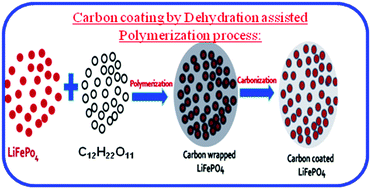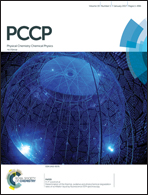Development of a novel carbon-coating strategy for producing core–shell structured carbon coated LiFePO4 for an improved Li-ion battery performance†
Abstract
In the present study, LiFePO4 (LFP) has been synthesized using a flame spray pyrolysis unit followed by carbon coating on LFP using a novel strategy of dehydration assisted polymerization process (DAP) in order to improve its electronic conductivity. Characterization studies revealed the presence of a pure LFP structure and the formation of a thin, uniform and graphitic carbon layer with a thickness of 6–8 nm on the surface of the LFP. A carbon coated LFP with 3 wt% of carbon, using a DAP process, delivered a specific capacity of 167 mA h g−1 at a 0.1C rate, whereas LFP carbon coated by a carbothermal process (CLFP-C) delivered a capacity of 145 mA h g−1 at 0.1C. Further carbon coated LFP by the DAP exhibited a good rate capability and cyclic stability. The enhanced electrochemical performance of C-LFP by DAP is attributed to the presence of a uniform, thin and ordered graphitic carbon layer with a core–shell structure, which greatly increased the electronic conductivity of LFP and thereby showed an improved electro-chemical performance. Interestingly, the developed carbon coating process has been extended to synthesize a bulk quantity (0.5 kg) of carbon coated LFP under optimized experimental conditions as a part of up-scaling and the resulting material electro-chemical performance has been evaluated and compared with commercial electrode materials. Bulk C-LFP showed a capacity of 131 mA h g−1 and 87 mA h g−1 at a rate of 1C and at 10C, respectively, illustrating that the developed DAP process greatly improved the electrochemical performance of LFP in terms of rate capability and cyclic stability, not only during the lab scale synthesis but also during the large scale synthesis. Benchmark studies concluded that the electro-chemical performance of C-LFP by DAP is comparable with that of TODA LFP and better than that of UNTPL LFP. The DAP process developed in the present study can be extended to other electrode materials as well.


 Please wait while we load your content...
Please wait while we load your content...